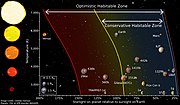Kepler-452 is a G-type main-sequence star located about 1,810 light-years away from Earth in the Cygnus constellation. Although similar in temperature...
13 KB (1,189 words) - 08:01, 9 May 2024
the habitable zone of the sun-like star Kepler-452 and is the only planet in the system discovered by the Kepler space telescope. It is located about 1...
21 KB (2,002 words) - 19:19, 14 December 2024
gravity twice as great. A G2V-type yellow dwarf like the Sun belongs to Kepler-452, with an estimated age of 6 billion years (6 Ga) versus the solar system's...
35 KB (3,480 words) - 05:39, 11 December 2024
Page: Kepler-296 f". NASA Exoplanet Archive. NASA Exoplanet Science Institute. Retrieved 4 June 2016. "Confirmed Planet Overview Page: Kepler-452 b". NASA...
58 KB (3,095 words) - 13:04, 26 December 2024
is host to exoplanets Kepler-37b, Kepler-37c, Kepler-37d and possibly Kepler-37e, all of which orbit very close to it. Kepler-37 has a mass about 80...
16 KB (1,411 words) - 05:26, 23 August 2024
1088/2041-8205/774/2/L32. S2CID 56111132. Kepler-452 at SIMBAD - Ids - Bibliography - Image. "Planet Kepler-452 b". Extrasolar Planets Encyclopaedia. Retrieved...
39 KB (3,470 words) - 18:38, 8 November 2024
Kepler-37b is an exoplanet orbiting the star Kepler-37 in the constellation Lyra. As of February 2013[update], it is the smallest planet discovered around...
11 KB (887 words) - 18:23, 24 July 2024
Earth days to orbit the habitable zone of its G-class (solar analog) star Kepler-452. The discovery of a system of three tidally-locked planets orbiting the...
134 KB (13,720 words) - 16:19, 6 November 2024
billion years (6.0 Gya): Formation of Earth's near twin, Kepler-452b orbiting its parent star Kepler-452 7.98 billion years (5.82 Gya): Formation of Mira or...
36 KB (5,008 words) - 11:47, 31 December 2024
fundamental properties of Kepler exoplanet host stars from asteroseismology". Monthly Notices of the Royal Astronomical Society. 452 (2): 2127–2148. arXiv:1504...
15 KB (682 words) - 04:16, 18 July 2024
List of stars in Cygnus (redirect from Kepler-533)
Dennis; Zhou, Yixiao; White, Timothy R. (2020), "Asteroseismology of 36 Kepler subgiants – I. Oscillation frequencies, linewidths, and amplitudes", Monthly...
64 KB (298 words) - 17:52, 29 December 2024
Society on January 4, 2010, along with Kepler-5, Kepler-6, Kepler-7, and Kepler-8. Of the presented planets, Kepler-4b was the smallest, around the size...
14 KB (1,014 words) - 21:05, 19 December 2024
Kepler Mire The Kepler Mire, or Dismal Swamp east of Lake Manapouri, is the largest wetland in the Te Anau basin complex in New Zealand, covering more...
2 KB (252 words) - 21:52, 22 July 2024
Kepler-37c is an exoplanet discovered by the Kepler space telescope in February 2013. With an orbital period of 21 days, it is located 209 light-years...
4 KB (316 words) - 07:51, 31 October 2023
Kepler-51 is a Sun-like star that is about 500 million years old. It is orbited by four planets—Kepler-51b, c, d and e—first three of which are super-puffs...
12 KB (1,162 words) - 17:43, 29 December 2024
Kepler-1649c is an Earth-sized exoplanet, likely rocky, orbiting within the habitable zone of the red dwarf star Kepler-1649, the outermost planet of...
10 KB (885 words) - 21:09, 14 January 2024
Kepler-283 c is an exoplanet orbiting the K-type star Kepler-283 every 93 days in the circumstellar habitable zone, discovered by the Kepler space telescope...
4 KB (206 words) - 16:25, 13 August 2024
fundamental properties of Kepler exoplanet host stars from asteroseismology". Monthly Notices of the Royal Astronomical Society. 452 (2): 2127–2148. arXiv:1504...
20 KB (1,027 words) - 01:23, 22 December 2024
Kepler-22 is a Sun-like star in the northern constellation of Cygnus, the swan, that is orbited by at least 1 planet found to be unequivocally within the...
10 KB (661 words) - 01:51, 27 December 2024
Kepler-37d is an exoplanet discovered by the Kepler space telescope in February 2013. It is located 209 light years away, in the constellation Lyra. With...
7 KB (576 words) - 00:15, 2 September 2024
two planets announced are designated Kepler-47b, and Kepler-47c, and the third, later discovery is Kepler-47d. Kepler-47 is the first circumbinary multi-planet...
23 KB (2,151 words) - 08:11, 17 November 2024
Kepler-186 is a main-sequence M1-type dwarf star, located 177.5 parsecs (579 light years) away in the constellation of Cygnus. The star is slightly cooler...
17 KB (1,540 words) - 03:22, 3 November 2024
Kepler-385 (also designated KOI-2433) is an F-type main-sequence star located about 4,900 light-years (1,500 parsecs) away from Earth in the constellation...
7 KB (471 words) - 19:30, 20 September 2024
Kepler-70, also known as KIC 5807616 and KOI-55, is a star about 3,600 light-years (1,100 parsecs) away in the constellation Cygnus, with an apparent visual...
12 KB (1,094 words) - 18:13, 23 August 2024
Kepler-1708b (previously known as KIC 7906827.01) is a Jupiter-sized exoplanet orbiting the Sun-like star Kepler-1708, located in the constellation of...
14 KB (1,305 words) - 04:34, 21 November 2024
Kepler-1625b I is a possible moon of exoplanet Kepler-1625b, which may be the first exomoon ever discovered (pending confirmation), and was first indicated...
7 KB (602 words) - 20:19, 2 November 2024
Kepler-1625b is a super-Jupiter exoplanet orbiting the Sun-like star Kepler-1625 about 2,500 parsecs (8,200 light-years) away in the constellation of...
11 KB (1,060 words) - 20:18, 2 November 2024
Kepler-11, also designated as 2MASS J19482762+4154328, is a Sun-like star slightly larger than the Sun in the constellation Cygnus, located some 2,110...
18 KB (1,553 words) - 04:47, 29 August 2024
Kepler-42, formerly known as KOI-961, is a red dwarf located in the constellation Cygnus and approximately 131 light years from the Sun. It has three known...
12 KB (832 words) - 19:32, 30 November 2024
from the Kepler space telescope and confirmed in 2015. None of the planets orbit within the habitable zone. Kepler-445b, c, and d orbit Kepler-445 every...
6 KB (348 words) - 02:01, 27 September 2023
















